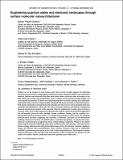Por favor, use este identificador para citar o enlazar a este item:
http://hdl.handle.net/10261/303278COMPARTIR / EXPORTAR:
 SHARE SHARE
 CORE
BASE CORE
BASE
|
|
| Visualizar otros formatos: MARC | Dublin Core | RDF | ORE | MODS | METS | DIDL | DATACITE | |

| Título: | Engineering quantum states and electronic landscapes through surface molecular nanoarchitectures |
Autor: | Piquero-Zulaica, Ignacio CSIC ORCID; Lobo-Checa, Jorge CSIC ORCID ; Abd El-Fattah, Z. M. CSIC ORCID; Ortega, J. Enrique CSIC ORCID; Klappenberger, Florian; Auwärter, Willi; Barth, Johannes V. | Fecha de publicación: | 2022 | Editor: | American Physical Society | Citación: | Reviews of Modern Physics 94(4): 045008 (2022) | Resumen: | Surfaces are at the frontier of every known solid. They provide versatile supports for functional nanostructures and mediate essential physicochemical processes. Intimately related to two-dimensional materials, interfaces and atomically thin films often feature distinct electronic states with respect to the bulk, which is key to many relevant properties, such as catalytic activity, interfacial charge-transfer, and crystal growth mechanisms. To induce novel quantum properties via lateral scattering and confinement, reducing the surface electrons’ dimensionality and spread with atomic precision is of particular interest. Both atomic manipulation and supramolecular principles provide access to custom-designed molecular assemblies and superlattices, which tailor the surface electronic landscape and influence fundamental chemical and physical properties at the nanoscale. Here the confinement of surface-state electrons is reviewed, with a focus on their interaction with molecular scaffolds created by molecular manipulation and self-assembly protocols under ultrahigh vacuum conditions. Starting with the quasifree two-dimensional electron gas present at the (111)-oriented surface planes of noble metals, the intriguing molecule-based structural complexity and versatility is illustrated. Surveyed are low-dimensional confining structures in the form of artificial lattices, molecular nanogratings, or quantum dot arrays, which are constructed upon an appropriate choice of their building constituents. Whenever the realized (metal-)organic networks exhibit long-range order, modified surface band structures with characteristic features emerge, inducing noteworthy physical phenomena such as discretization, quantum coupling or energy, and effective mass renormalization. Such collective electronic states can be additionally modified by positioning guest species at the voids of open nanoarchitectures. The designed scattering potential landscapes can be described with semiempirical models, bringing thus the prospect of total control over surface electron confinement and novel quantum states within reach. | Versión del editor: | https://doi.org/10.1103/RevModPhys.94.045008 | URI: | http://hdl.handle.net/10261/303278 | DOI: | 10.1103/RevModPhys.94.045008 | E-ISSN: | 1539-0756 |
| Aparece en las colecciones: | (CFM) Artículos (INMA) Artículos |
Ficheros en este ítem:
| Fichero | Descripción | Tamaño | Formato | |
|---|---|---|---|---|
| engineernanoar.pdf | 10,67 MB | Adobe PDF |  Visualizar/Abrir |
CORE Recommender
SCOPUSTM
Citations
11
checked on 21-may-2024
WEB OF SCIENCETM
Citations
5
checked on 24-feb-2024
Page view(s)
30
checked on 26-may-2024
Download(s)
122
checked on 26-may-2024
Google ScholarTM
Check
Altmetric
Altmetric
NOTA: Los ítems de Digital.CSIC están protegidos por copyright, con todos los derechos reservados, a menos que se indique lo contrario.
